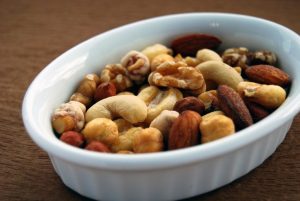Nuts can decrease risk of cancer

It is well known that nut consumption is associated with decreased risk of colorectal, endometrial, lung and pancreatic cancers. This latest study shows it also helps with gastric cancer and esophageal cancer.
In this study, the term “nut consumption” includes not only nuts, but also nut butters, including peanut butter.
The Research
Nut and peanut butter consumption and the risk of esophageal and gastric cancer subtypes
- Maryam Hashemian1,2,3,
- Gwen Murphy1,
- Arash Etemadi1,
- Sanford M Dawsey1,
- Linda M Liao1, and
- Christian C Abnet1
+Author Affiliations
- 1Metabolic Epidemiology Branch, Division of Cancer Epidemiology and Genetics, National Cancer Institute, Bethesda, MD;
- 2Departments of Nutrition and Biochemistry, Faculty of Medicine, Sabzevar University of Medical Sciences, Sabzevar, Iran; and
- 3Digestive Oncology Research Center, Digestive Diseases Research Institute, Tehran University of Medical Sciences, Tehran, Iran
+Author Notes
- Supported by the Intramural Research Program of the National Cancer Institute, NIH (https://dietandhealth.cancer.gov/acknowledgement.html).
- Supplemental Table 1 is available from the “Online Supporting Material” link in the online posting of the article and from the same link in the online table of contents at http://ajcn.nutrition.org.
- Address correspondence to CCA (e-mail: abnetc@mail.nih.gov).
Abstract
Background: Nut consumption has been associated with decreased risk of colorectal, endometrial, lung, and pancreatic cancers. Polyphenols, fiber, vitamins, and minerals in nuts may confer this observed protective effect. To our knowledge, no prospective study has evaluated the effect of nut consumption on esophageal and gastric cancers.
Objective: The objective was to evaluate the associations between nut and peanut butter consumption and the risk of esophageal and gastric cancers and their different subtypes.
Design: In this study we used data from the NIH-AARP Diet and Health Study, which enrolled 566,407 persons who were 50–71 y old at baseline (1995–1996). The median follow-up time was 15.5 y. Intakes of nuts and peanut butter were assessed through the use of a validated food-frequency questionnaire. We used Cox proportional hazard models to estimate HRs and 95% CIs for esophageal and gastric cancers and their subtypes.
Results: We identified 966 incident cases of esophageal adenocarcinomas, 323 cases of esophageal squamous cell carcinoma, 698 cases of gastric cardia adenocarcinoma, and 732 cases of gastric noncardia adenocarcinoma. Compared with those who did not consume nuts or peanut butter [lowest category of consumption (C0)], participants in the highest category of nut consumption (C3) had a lower risk of developing gastric noncardia adenocarcinoma [C3 compared with C0, HR: 0.73 (95% CI: 0.57, 0.94)]. This inverse association was also seen for peanut butter consumption [C3 compared with C0, HR: 0.75 (95% CI: 0.60, 0.94)]. We observed no significant associations between the highest and lowest intakes of nuts or peanut butter and the risk of gastric cardia adenocarcinoma, esophageal adenocarcinoma, or esophageal squamous cell carcinoma.
Conclusions: Among older American adults, both nut and peanut butter consumption were inversely associated with the risk of gastric noncardia adenocarcinoma. This trial was registered at clinicaltrials.gov as NCT00340015.











